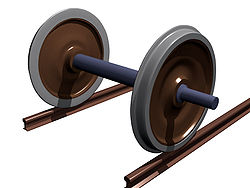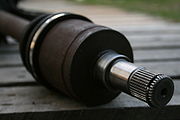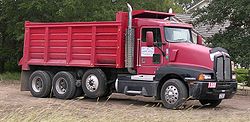
Axle
Encyclopedia

Rotation
A rotation is a circular movement of an object around a center of rotation. A three-dimensional object rotates always around an imaginary line called a rotation axis. If the axis is within the body, and passes through its center of mass the body is said to rotate upon itself, or spin. A rotation...
wheel
Wheel
A wheel is a device that allows heavy objects to be moved easily through rotating on an axle through its center, facilitating movement or transportation while supporting a load, or performing labor in machines. Common examples found in transport applications. A wheel, together with an axle,...
or gear
Gear
A gear is a rotating machine part having cut teeth, or cogs, which mesh with another toothed part in order to transmit torque. Two or more gears working in tandem are called a transmission and can produce a mechanical advantage through a gear ratio and thus may be considered a simple machine....
. On wheeled vehicles, the axle may be fixed to the wheels, rotating with them, or fixed to its surroundings, with the wheels rotating around the axle. In the former case, bearings
Bearing (mechanical)
A bearing is a device to allow constrained relative motion between two or more parts, typically rotation or linear movement. Bearings may be classified broadly according to the motions they allow and according to their principle of operation as well as by the directions of applied loads they can...
or bushings are provided at the mounting points where the axle is supported. In the latter case, a bearing or bushing sits inside the hole in the wheel to allow the wheel or gear to rotate around the axle. Sometimes, especially on bicycle
Bicycle
A bicycle, also known as a bike, pushbike or cycle, is a human-powered, pedal-driven, single-track vehicle, having two wheels attached to a frame, one behind the other. A person who rides a bicycle is called a cyclist, or bicyclist....
s, the latter type is referred to as a spindle
Spindle (tool)
In machine tools, a spindle is a rotating axis of the machine, which often has a shaft at its heart. The shaft itself is called a spindle, but also, in shop-floor practice, the word often is used metonymically to refer to the entire rotary unit, including not only the shaft itself, but its bearings...
.
On cars and trucks, several senses of the word "axle" co-occur in casual usage, referring to the shaft itself, its housing, or simply any transverse pair of wheels. The shaft itself rotates with the wheel, being either bolted or splined
Rotating spline
Splines are ridges or teethon a drive shaft that mesh with grooves in a mating piece and transfer torque to it, maintaining the angular correspondence between them....
in fixed relation to it, and is called an "axle" or "axle shaft". However, it is equally true that the housing around it (typically a casting
Sand casting
Sand casting, also known as sand molded casting, is a metal casting process characterized by using sand as the mold material.It is relatively cheap and sufficiently refractory even for steel foundry use. A suitable bonding agent is mixed or occurs with the sand...
) is also called an "axle" (or "axle housing"). An even broader (somewhat figurative) sense of the word refers to every transverse pair of wheels, whether they are connected to each other or not. Thus even transverse pairs of wheels in an independent suspension
Independent suspension
Independent suspension is a broad term for any automobile suspension system that allows each wheel on the same axle to move vertically independently of each other. This is contrasted with a beam axle, live axle or deDion axle system in which the wheels are linked – movement on one side affects...
are usually called "an axle".
Vehicle axles
Axles are an integral component of a wheeled vehicleVehicle
A vehicle is a device that is designed or used to transport people or cargo. Most often vehicles are manufactured, such as bicycles, cars, motorcycles, trains, ships, boats, and aircraft....
. In a live-axle suspension system, the axles serve to transmit driving torque
Torque
Torque, moment or moment of force , is the tendency of a force to rotate an object about an axis, fulcrum, or pivot. Just as a force is a push or a pull, a torque can be thought of as a twist....
to the wheel, as well as to maintain the position of the wheels relative to each other and to the vehicle body. The axles in this system must also bear the weight of the vehicle plus any cargo
Cargo
Cargo is goods or produce transported, generally for commercial gain, by ship, aircraft, train, van or truck. In modern times, containers are used in most intermodal long-haul cargo transport.-Marine:...
. A non-driving axle, such as the front beam axle in Heavy duty trucks and some 2 wheel drive light trucks and vans, will have no shaft. It serves only as a suspension and steering component. Conversely, many front wheel drive cars have a solid rear beam axle.
In other types of suspension systems, the axles serve only to transmit driving torque to the wheels; The position and angle of the wheel hubs is a function of the suspension system. This is typical of the independent suspension
Independent suspension
Independent suspension is a broad term for any automobile suspension system that allows each wheel on the same axle to move vertically independently of each other. This is contrasted with a beam axle, live axle or deDion axle system in which the wheels are linked – movement on one side affects...
found on most newer cars and SUV's, and on the front of many light trucks. These systems still have a differential, but it will not have attached axle housing tubes. It may be attached to the vehicle frame or body, or integral in a transaxle
Transaxle
In the automotive field, a transaxle is a major mechanical component that combines the functionality of the transmission, the differential, and associated components of the driven axle into one integrated assembly....
. The axle shafts (usually C.V. type) then transmit driving torque to the wheels. Like a full floating axle system, the shafts in an independent suspension system do not support and vehicle weight.
"Axle" in reference to a vehicle also has a more ambiguous definition, meaning parallel wheels on opposing sides of the vehicle, regardless of their mechanical connection type to each other and the vehicle frame or body.
Structural features

Train
A train is a connected series of vehicles for rail transport that move along a track to transport cargo or passengers from one place to another place. The track usually consists of two rails, but might also be a monorail or maglev guideway.Propulsion for the train is provided by a separate...
s, for the rear axles of commercial truck
Truck
A truck or lorry is a motor vehicle designed to transport cargo. Trucks vary greatly in size, power, and configuration, with the smallest being mechanically similar to an automobile...
s, and on heavy duty off-road vehicles. The axle can be protected and further reinforced by enclosing the length of the axle in a housing.
In split-axle designs, the wheel on each side is attached to a separate shaft. Modern passenger cars have split drive axles. In some designs, this allows independent suspension
Independent suspension
Independent suspension is a broad term for any automobile suspension system that allows each wheel on the same axle to move vertically independently of each other. This is contrasted with a beam axle, live axle or deDion axle system in which the wheels are linked – movement on one side affects...
of the left and right wheels, and therefore a smoother ride. Even when the suspension is not independent, split axles permit the use of a differential, allowing the left and right drive wheels to be driven at different speeds as the automobile turns, improving traction and extending tire life.
A tandem axle is a group of two or more axles situated close together. Trucks designs will use such a configuration to provide a greater weight capacity than a single axle. Semi trailers usually have a tandem axle at the rear.
Drive axles

Modern front wheel drive cars typically combine the transmission
Transmission (mechanics)
A machine consists of a power source and a power transmission system, which provides controlled application of the power. Merriam-Webster defines transmission as: an assembly of parts including the speed-changing gears and the propeller shaft by which the power is transmitted from an engine to a...
and front axle into a single unit called a transaxle
Transaxle
In the automotive field, a transaxle is a major mechanical component that combines the functionality of the transmission, the differential, and associated components of the driven axle into one integrated assembly....
. The drive axle is a split axle with a differential
Differential (mechanics)
A differential is a device, usually, but not necessarily, employing gears, capable of transmitting torque and rotation through three shafts, almost always used in one of two ways: in one way, it receives one input and provides two outputs—this is found in most automobiles—and in the other way, it...
and universal joint
Universal joint
A universal joint, universal coupling, U joint, Cardan joint, Hardy-Spicer joint, or Hooke's joint is a joint or coupling in a rigid rod that allows the rod to 'bend' in any direction, and is commonly used in shafts that transmit rotary motion...
s between the two half axles. Each half axle connects to the wheel by use of a constant velocity (CV) joint
Constant-velocity joint
Constant-velocity joints allow a drive shaft to transmit power through a variable angle, at constant rotational speed, without an appreciable increase in friction or play. They are mainly used in front wheel drive and all wheel drive cars...
which allows the wheel assembly to move freely vertically as well as to pivot when making turns.
In rear wheel drive cars and trucks, the engine turns a driveshaft
Driveshaft
A drive shaft, driveshaft, driving shaft, propeller shaft, or Cardan shaft is a mechanical component for transmitting torque and rotation, usually used to connect other components of a drive train that cannot be connected directly because of distance or the need to allow for relative movement...
which transmits rotational force to a drive axle at the rear of the vehicle. The drive axle may be a live axle
Live axle
A live axle, sometimes called a solid axle, is a type of beam axle suspension system that uses the driveshafts that transmit power to the wheels to connect the wheels laterally so that they move together as a unit....
, but modern automobiles generally use a split axle with a differential.
Some simple vehicle designs, such as lesiure go-kart
Go-kart
thumb|A [[Kart racing|racing kart]] at the [[Commission Internationale de Karting|CIK-FIA]] European Championship 2008A go-kart is a small four-wheeled vehicle...
s, may have a single driven wheel where the drive axle is a split axle with only one of the two shafts driven by the engine, or else have both wheels connected to one shaft without a differential (kart racing
Kart racing
Kart racing or karting is a variant of open-wheel motorsport with small, open, four-wheeled vehicles called karts, go-karts, or gearbox/shifter karts depending on the design. They are usually raced on scaled-down circuits...
).
Dead axles/lazy axles

Some dump truck
Dump truck
A dump truck is a truck used for transporting loose material for construction. A typical dump truck is equipped with a hydraulically operated open-box bed hinged at the rear, the front of which can be lifted up to allow the contents to be deposited on the ground behind the truck at the site of...
s and trailers are configured with lift axles (also known as airlift axles or drop axles), which may be mechanically raised or lowered. The axle is lowered to increase the weight capacity, or to distribute the weight of the cargo over more wheels, for example to cross a weight restricted bridge
Bridge
A bridge is a structure built to span physical obstacles such as a body of water, valley, or road, for the purpose of providing passage over the obstacle...
. When not needed, the axle is lifted off the ground to save wear on the tires and axle and to increase traction in the remaining wheels. Lifting an axle also makes the vehicle perform better on tighter turns.
Several manufacturers offer computer-controlled airlift, so that the dead axles are automatically lowered when the main axle reaches its weight limit. The dead axles can still be lifted by the press of a button if needed.
Full-floating vs semi-floating vs Non-floating
The full-floating design is typically used in most 3/4 and 1-ton light trucks, medium duty trucks and heavy-duty trucks, as well as most agricultural applications, such as large tractors and combines. There are a few exceptions, such as many Land-Rover vehicles. A full-floating axle can be identified by a protruding hub to which the axle shaft flange is bolted. These axles can carry more weight than a semi-floating or non-floating axle assembly because the hubs have two bearings riding on a fixed spindle. The axle shafts themselves do not carry any weight; they serve only to transmit torque from the differential to the wheels. Full-floating axle shafts are retained by the aforementioned flange bolted to the hub, while the hub and bearings are retained on the spindle by a large nut.The semi-floating and non-floating design carry the weight of the vehicle on the axle shaft itself; there is a single bearing at the end of the axle housing that carries the load from the axle and that the axle rotates through. With a semi-floating axle, the axles themselves serve as the inner bearing race and are retained by c-clips that are in the differential carrier. Non-floating axles have the bearings (with inner races) pressed onto the axle shaft (usually accompanied by a snap-ring), and are retained by a plate that bolts to a flange on the axle housing. Both of these designs are found under most 1/2 ton and lighter trucks and SUV's, and rear or all-wheel drive cars with live axle suspension, though the non-floating type all but disappeared in American cars and trucks during the late 1970s.
See also
- Klien-Lindner axleKlien-Lindner axleThe Klien-Lindner axle is a special type of hollow driving axle on steam locomotives that enable better curve running due to its ability to slide transversely...
- Portal axle
- Wheel and axleWheel and axleThe wheel and axle is one of six simple machines developed in ancient times and is in the category of a second- or third-class lever. In its simplest form it consists of a rod attached to a wheel so that their movements are coupled when one of the parts is turned...

